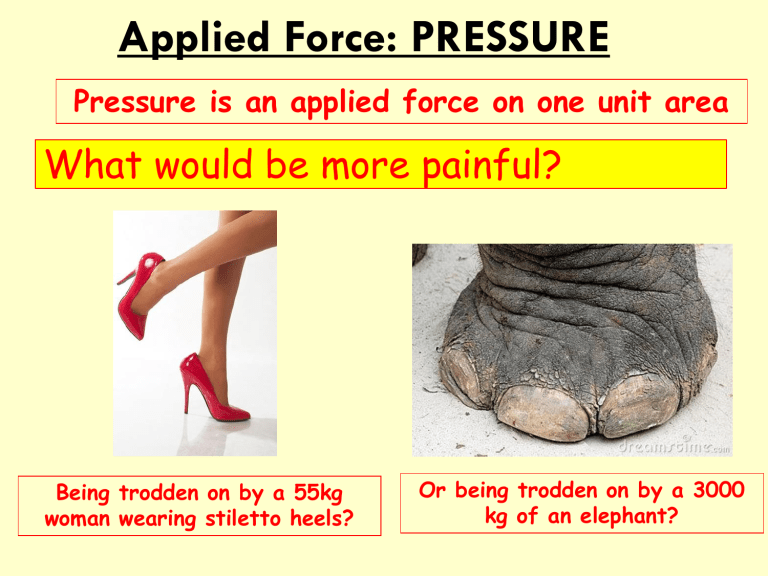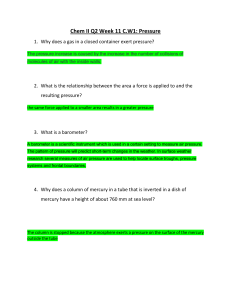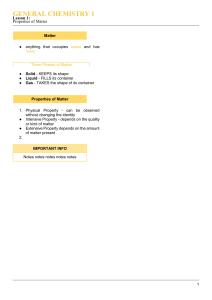
Applied Force: PRESSURE Pressure is an applied force on one unit area What would be more painful? Being trodden on by a 55kg woman wearing stiletto heels? Or being trodden on by a 3000 kg of an elephant? What would be more painful? Being trodden on by a 55kg woman wearing stiletto heels? Or being trodden on by a 3 tonne elephant? The woman’s foot in the stiletto heel! The whole of the woman’s weight is concentrated on a very small area, whereas the elephant’s weight is much more spread out – it exerts less pressure! Calculating pressure for solid Pressure = Force area Unit of Pressure is Pascal (Pa) Unit of Force is Newton (N) Unit of area is m2 Calculating pressure 1. A box on the floor has a weight of 250 newtons. The area that the box rests on is 0.25m2. calculate the pressure under the box Pressure = 2. A hose causes a force of 8000N from the water over an area of 0.5m by 0.5m. Calculate the pressure. Pressure = Examples of Pressure in real life 1. Increase the pressure by reducing the area. The area under the edge of the blade of the knife is very small. Beneath it the pressure is very high, so the blade can be pushed easily through materials such as fruit. The studs on a football boot have a small area of contact with the ground. This means that the pressure beneath the studs is sufficient for them to sink into the ground and provide additional grip. Examples of Pressure 2. Reduce the pressure by increasing the area. Skis have a large area to reduce the pressure on the snow so they do not sink in too deep. Wall foundations have a large horizontal area. This reduces the pressure beneath so that the wall does not sink deeper into the ground. There will always be force of nature in life (problems/limitations/consequences). Minimize the pressures by improving your knowledge, your acceptance, your degree of patience, discussion/communication. Pressure of liquids The weight of the liquid causes pressure in the container. It also causes pressure on any side of the container. Properties: Pressure increases with depth. The deeper a liquid, the greater the weight above and so the higher the pressure. This is why dams are built with a taper towards a thicker base. P= ρ.g.h ρ= density of liquid, g= gravity, h= depth Pressure of liquids The weight of the liquid causes pressure in the container. It also causes pressure on any object in the liquid. Properties: Pressure doesn’t depend upon the shape of the container. The pressure at any particular depth is the same whatever the shape or width of the container. http://www.physics.arizona.edu/~hoffman/ua200/fluids/2b2040.gif Pressure worksheet 1: 1. (a) What is the pressure of a 20 kg box with 2x3 m area towards a table ? (b) if the dimension of the box is 2x3x4 m, what is the maximum pressure that it can be exerted towards the table? (c) What is the minimum pressure that can be exerted by the the box towards the table? 2. If water is poured into the box (2x3x4 m) until it is full and put on the table on the 2x3 m side. Calculate the pressure from water: (a) in the middle of the box (b) at the bottom of the box (density of water= 1000 kg/m3) 3. (a) Calculate the pressure of an elephant to the ground if its mass is 4000 kg while the area of its foot is 0.3 m2. (b) Compare it with the pressure from a woman in high heels shoes if the mass of the woman is 40 kg and the area of a high heel shoe is 2.5x10-5 m2 Air Pressure Air pressure in the atmosphere acts in all directions. Air pressure gets less as you rise up through the atmosphere. The atmosphere is denser at lower levels. At sea level, atmospheric pressure is about 100 kPa Air Pressure We can measure atmospheric pressure using a barometer. The sealed tube contains a vacuum. Air pressure will push mercury up the tube. At sea level a column of 760 mm of mercury can be supported. 760 mm Hg= 1 atm= 101,325 Pa. The Manometer A manometer measures pressure difference. The height difference (h) compares the pressure being measured with the atmospheric pressure. h Pressure of P (the gas container is: P=air pressure+ ρ.g.h Pressure worksheet 2: 1. Mercury has density of 13.6 g/cm3=13,600 kg/m3. The column of mercury in the manometer below added by h = 50 cm=0.5 m (a) what is the additional pressure to the air pressure? (b) what is the total pressure if the the atmospheric pressure is 1 atm. 2. A barometer shows the pressure of a gas shown on picture below. The height is 76 cm. The density of mercury is 13.6 g/cm3 =13,600 kg/m3 .The density of water=1 g/cm3=1000 kg/ m3. (a) what is the air pressure? (b) If a similar barometer were made with water,what would be the approximate height h of the column of water ()? Hydraulics Driver presses down on jack handle here Car is lifted by jack here By putting much bigger area at the other end, the force produced will be much more. It is using Pascal’s law: Pressure at any linear point is the same. F1/A1=F2/A2 Hydraulics Driver presses down on jack handle here Car is lifted by jack here Force = 100 N Area = 10 cm2 Area = 4000 cm2 Pressure = The force that can be produced? maximum mass of car?



